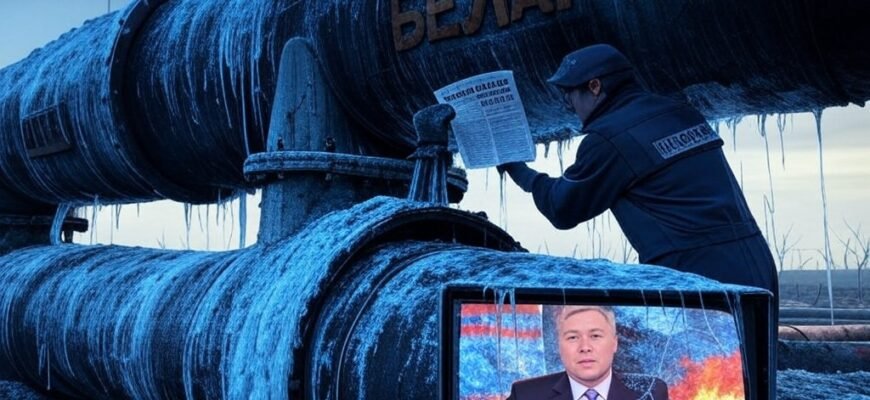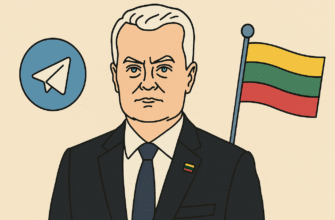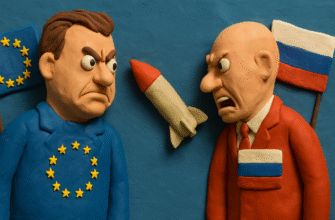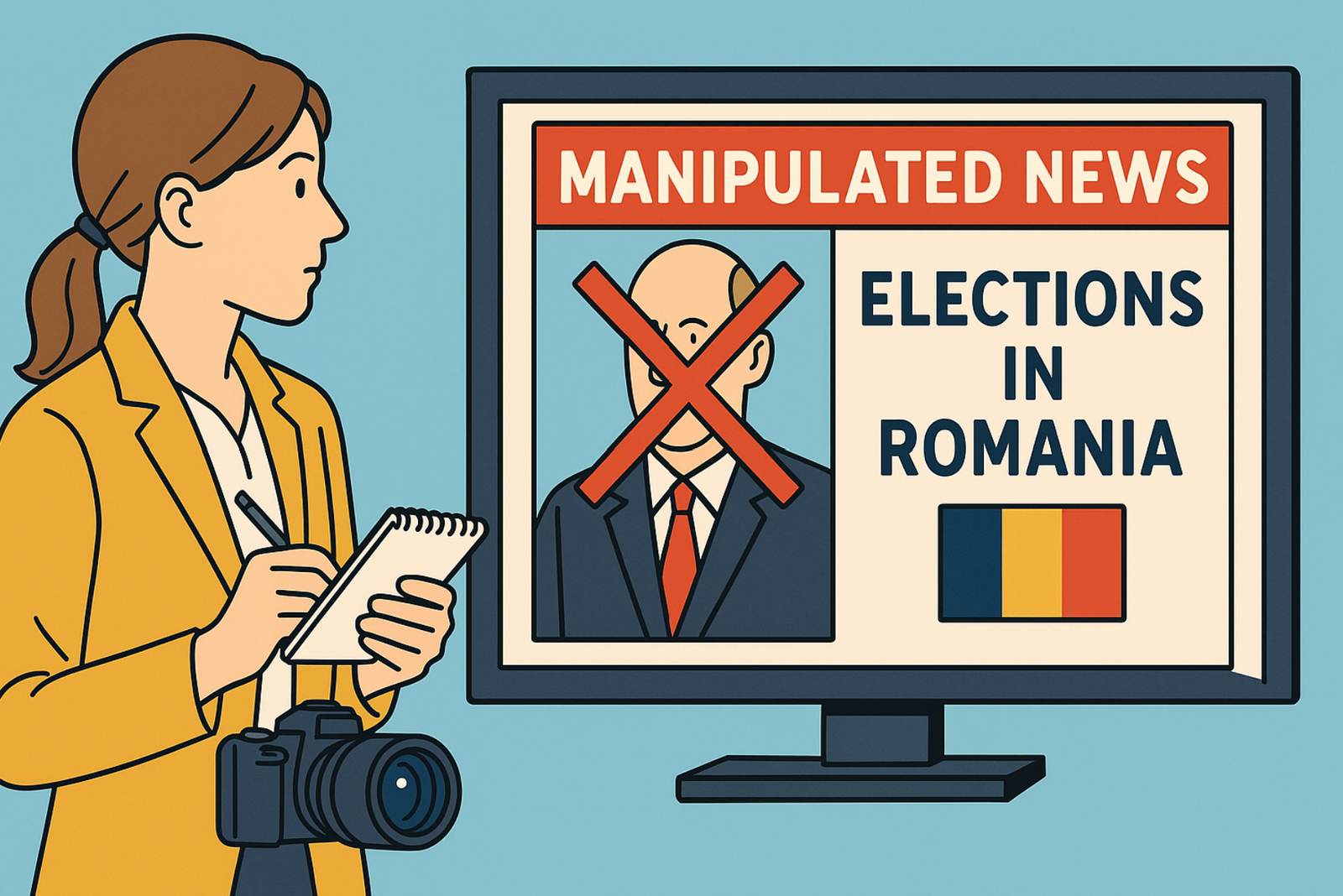February 24, 2025 marks three years of the full-scale invasion of the Russian Federation on the territory of Ukraine.
As part of monitoring YouTube channels of Belarusian media with state ownership, a dataset was collected for the period from January 1 to February 21, 2025, which consists of 2484 entries across five channels. Each of the channels is a “golden button” of YouTube, as the number of subscribers exceeds one million.
The share of subscribers from Russia on the studied channels:
- CTVBY – 44.5% of 1.7 million subscribers;
- СБТВ – 60.8% of 1.4 million subscribers;
- ONT TV Channel – 40% of 1.3 million subscribers;
- NEWS.BY: news of Belarus and the world – 52.7% of 1.4 million subscribers;
- BelTA News Agency – 57.5% of 1.9 million subscribers.
All posts were transcribed into text using speech-to-text LLMs. Then an analysis was conducted for disinformation narratives, using a fine-tuned 4o-mini model and semantic analysis.
For further processing, only posts with war in Ukraine themes in their headlines were selected. All presented results were analyzed only on the subset of data that passed filtration for Ukrainian topics, which allows focusing specifically on disinformation related to Ukraine.
Total videos for analysis: 443 (18.22% of the total). Total views of these videos exceeded 80 million.
| Channel | Number of videos | Views | Likes | Comments |
|---|---|---|---|---|
| CTVBY | 126 | 56,414,900 | 1,186,175 | 63,614.0 |
| СБТВ | 111 | 7,477,636 | 251,540 | 13,556.0 |
| ONT TV Channel | 75 | 4,264,973 | 83,021 | 7,008.0 |
| NEWS.BY: news of Belarus and the world | 70 | 4,039,305 | 55,257 | 5,261.0 |
| BelTA News Agency | 61 | 8,489,077 | 236,228 | 30,031.0 |
The scale of Belarusian propaganda’s involvement in the process of disinforming its audience about the war in Ukraine can be assessed by videos that collected the most views:
| Date | Title | Channel | Views | Likes | Comments |
|---|---|---|---|---|---|
| 2025-01-26 | Lukashenko named the causes of the conflict in Ukraine! #lukashenko #putin #war #ukraine #svo #news | CTVBY | 4,301,215 | 156,487 | 4,200.0 |
| 2025-02-17 | The US is going to negotiations because Russia has won! #politics #ukraine #war #news #svo #trump | CTVBY | 3,048,226 | 78,135 | 4,800.0 |
| 2025-01-26 | Lukashenko harshly on Zelensky’s insane statement! #lukashenko #politics #ukraine #zelensky #war | CTVBY | 2,677,814 | 70,626 | 1,600.0 |
| 2025-01-02 | Incident with Polish military near the borders of Belarus! #politics #emergency #news #poland #border #belarus | CTVBY | 1,878,291 | 26,133 | 644.0 |
| 2025-01-26 | Lukashenko: Russia will not return Crimea! #lukashenko #ukraine #war #svo #politics #russia #news | CTVBY | 1,838,632 | 43,833 | 2,100.0 |
| 2025-02-17 | Details of Trump and Putin negotiations #politics #fatigarov #ukraine #war #news #svo #trump | CTVBY | 1,837,668 | 27,169 | 1,000.0 |
| 2025-01-07 | Ukrainians are disappointed with Zelensky! #zelensky #war #ukraine #svo #politics #afu #news #shorts | CTVBY | 1,737,598 | 27,150 | 2,800.0 |
| 2025-02-03 | Gaidukevich: How does Biden differ from Trump? #ukraine #war #trump #biden #svo #politics #news | CTVBY | 1,567,677 | 30,623 | 655.0 |
| 2025-02-15 | EU politicians upset at Trump and Putin! #politics #war #svo #putin #trump #ukraine #zelensky | CTVBY | 1,567,583 | 25,880 | 765.0 |
| 2025-02-08 | Poland closes doors for Ukrainian refugees! #poland #politics #ukraine #war #migrants #news | CTVBY | 1,566,913 | 25,843 | 2,500.0 |
Ukrainian topic coverage dynamics chart:

The chart of Ukrainian topic coverage dynamics on Belarusian YouTube channels reflects the functioning of a systematic mechanism for distributing one-sided information bypassing sanctions restrictions. The high proportion of Russian subscribers and significant viewership peaks demonstrate the effectiveness of this mechanism in spreading narratives of the aggressor country – the Russian Federation.
Particularly revealing are the spikes in activity on January 26 and in the run-up to the anniversary of the full-scale invasion, when Belarusian channels were used for massive promotion of a certain interpretation of events.
Formally acting as a “third party,” these media resources actually function as an alternative channel for delivering one-sided information, which allows bypassing platform restrictions and maintaining access to a wide audience for narratives that would otherwise be limited by YouTube’s sanctions policy.
Another chart clearly shows the relationship between the number of posted videos and the number of views:

The most frequently used disinformation narratives in posts on Ukrainian topics:

This chart represents the distribution of the 20 most frequently used disinformation narratives out of the 318 unique narratives detected in the studied Belarusian YouTube channels when covering Ukrainian topics.
- Dominant narratives:
- “Anti-elitism” (≈280 mentions) – the most common specific narrative
- “Global conspiracy” (≈240 mentions) – second most frequent
- “Dehumanization” (≈230 mentions) – third most frequent
- “Anti-Western narrative” (≈70 mentions) – significantly behind the top three
- Distribution structure:
- There is a strong bias toward the three leading narratives, which significantly outpace the rest
- There is a large gap between the third (“dehumanization” ≈230) and fourth (“anti-Western narrative” ≈70) narratives
- The “Others” category (≈380 mentions) exceeds any individual narrative, indicating a large variety of less frequent narratives
- Thematic clusters:
- Dehumanization narratives: basic “dehumanization” (≈230), “dehumanization of opponents” (≈15), “dehumanization of the enemy” (≈15), “dehumanization of the West” (≈10)
- Opposition narratives: “dehumanization of the opposition” (≈15), “discrediting the opposition” (≈5)
- Anti-Western narratives: “anti-Western narrative” (≈70), “anti-Americanism” (≈45)
- Conspiracy narratives: “global conspiracy” (≈240), “conspiracy narrative” (≈15)
- Patriotic narratives: “patriotism” (≈15), “patriotism and unity” (≈10), “positive narrative about Belarus” (≈10)
- Instrumental narratives:
- “Fostering distrust” (≈50) ranks fifth, indicating the importance of undermining confidence in information sources
- “Political manipulation” (≈20) and “security threat” (≈15) are used as tools for shaping perception
- “Economic instability” (≈10) is employed to increase audience anxiety
Strategic analysis
- Multi-level structure of disinformation:
- Basic narratives (“anti-elitism”, “global conspiracy”, “dehumanization”) create the foundation for more specific narratives
- Secondary narratives develop and concretize the main themes
- Numerous rare narratives (the “Others” category) provide flexibility and adaptability to the disinformation system
- Comprehensive impact strategy:
- Delegitimization: undermining the legitimacy of Ukrainian and Western authorities through “anti-elitism”
- Conspirologization: forming a distorted worldview through “global conspiracy”
- Dehumanization: reducing empathy for victims through various forms of dehumanization
- Radicalization: intensifying division through “anti-Ukrainian narrative”, “anti-Western narrative”
- Focus on elites and the system:
- The dominance of “anti-elitism” and “global conspiracy” indicates a strategy of redirecting discontent toward political elites and the global system
- This allows creating an image of an “external enemy” and distracting from internal problems
What current conclusions can be drawn from this chart?
- Systemic nature of disinformation:
- The chart demonstrates not a random set of narratives, but a well-structured system of complementary messages
- Three key narratives form the basis, while the rest perform auxiliary functions
- High level of structuring:
- The presence of 318 unique narratives indicates a high level of diversity and detail in disinformation messages
- At the same time, the concentration of mentions in several key narratives indicates purposefulness and a strategic approach
- Echo chamber effect:
- The use of the same narratives multiple times creates an effect of their credibility through repetition
- The mutual reinforcement of different narratives (e.g., “anti-elitism” + “global conspiracy”) creates a pseudo-logical worldview
- Instrumental approach to disinformation:
- The chart reflects a professional approach to constructing disinformation, where different narratives perform specific functions
- This indicates the directed and coordinated nature of disinformation campaigns in the channels studied
This chart represents not just statistics of mentions, but a visualization of a complex ecosystem of disinformation aimed at shaping a certain perception of Ukrainian topics among the Russian-speaking audience of Belarusian YouTube channels.
Such a high level of disinformation narratives leads to a high level of risks:

Comparative table of narratives
| Narrative | CTVBY | СБТВ | BelTA News Agency | ONT TV Channel | NEWS.BY: news of Belarus and the world | Total |
|---|---|---|---|---|---|---|
| 1. anti-elitism | 73 | 76 | 37 | 48 | 36 | 270 |
| 2. global conspiracy | 60 | 65 | 34 | 44 | 33 | 236 |
| 3. dehumanization | 60 | 66 | 38 | 36 | 27 | 227 |
| 4. anti-Western narrative | 14 | 16 | 12 | 9 | 15 | 66 |
| 5. fostering distrust | 12 | 5 | 13 | 5 | 8 | 43 |
| 6. anti-Americanism | 10 | 11 | 7 | 8 | 5 | 41 |
| 7. anti-Ukrainian narrative | 11 | 0 | 0 | 6 | 5 | 22 |
| 8. anti-elite narrative | 3 | 4 | 2 | 0 | 2 | 11 |
| 9. political manipulation | 5 | 0 | 0 | 2 | 2 | 9 |
| 10. security threat | 6 | 0 | 0 | 0 | 0 | 6 |
| 11. dehumanization of the enemy | 0 | 4 | 0 | 0 | 2 | 6 |
| 12. dehumanization of opponents | 2 | 0 | 3 | 0 | 0 | 5 |
| 13. economic instability | 3 | 0 | 0 | 2 | 0 | 5 |
| 14. patriotism | 2 | 3 | 0 | 0 | 0 | 5 |
| 15. dehumanization of the opposition | 2 | 0 | 0 | 0 | 3 | 5 |
| 16. patriotism and unity | 0 | 4 | 0 | 0 | 0 | 4 |
| 17. conspiracy narrative | 0 | 0 | 0 | 0 | 4 | 4 |
| 18. dehumanization of the West | 0 | 0 | 0 | 2 | 2 | 4 |
| 19. conspirology | 0 | 2 | 0 | 0 | 2 | 4 |
| 20. anti-democratic narrative | 0 | 0 | 0 | 4 | 0 | 4 |
| 21. economic crisis | 3 | 0 | 0 | 0 | 0 | 3 |
| 22. discrediting the opposition | 0 | 3 | 0 | 0 | 0 | 3 |
| 23. heroization | 0 | 3 | 0 | 0 | 0 | 3 |
| 24. positive narrative about Belarus | 0 | 0 | 0 | 0 | 3 | 3 |
| 25. fear and anxiety | 0 | 2 | 0 | 0 | 0 | 2 |
| 26. patriotism and traditional values | 0 | 0 | 2 | 0 | 0 | 2 |
| 27. collectivism | 0 | 2 | 0 | 0 | 0 | 2 |
| 28. cultural identity | 0 | 0 | 2 | 0 | 0 | 2 |
| 29. geopolitical manipulation | 0 | 0 | 0 | 2 | 0 | 2 |
| 30. state support | 0 | 0 | 0 | 0 | 2 | 2 |
| 31. economic threat | 0 | 0 | 0 | 2 | 0 | 2 |
| 32. anti-NATO | 2 | 0 | 0 | 0 | 0 | 2 |
| 33. legitimizing authority | 0 | 2 | 0 | 0 | 0 | 2 |
| 34. positive image of authority | 0 | 0 | 0 | 2 | 0 | 2 |
| 35. peacemaking narrative | 2 | 0 | 0 | 0 | 0 | 2 |
| 36. national pride | 2 | 0 | 0 | 0 | 0 | 2 |
| 37. nationalistic narrative | 0 | 0 | 2 | 0 | 0 | 2 |
| 38. psychological manipulation | 0 | 0 | 2 | 0 | 0 | 2 |
| 39. political stability | 2 | 0 | 0 | 0 | 0 | 2 |
| 40. interfaith unity | 0 | 0 | 2 | 0 | 0 | 2 |
| 41. information war | 0 | 0 | 0 | 0 | 2 | 2 |
| 42. anti-commercialism | 0 | 0 | 2 | 0 | 0 | 2 |
| 43. dehumanization of opponents | 0 | 2 | 0 | 0 | 0 | 2 |
| 44. distrust of Western institutions | 2 | 0 | 0 | 0 | 0 | 2 |
| 45. protection of personal information | 0 | 0 | 0 | 1 | 0 | 1 |
| 46. populism | 0 | 1 | 0 | 0 | 0 | 1 |
| 47. call for mobilization | 0 | 0 | 1 | 0 | 0 | 1 |
| 48. threat of war | 0 | 0 | 1 | 0 | 0 | 1 |
| 49. optimism in conflict | 0 | 0 | 1 | 0 | 0 | 1 |
| 50. protection of sovereignty | 0 | 0 | 0 | 1 | 0 | 1 |
| 51. myth of Western threat | 0 | 1 | 0 | 0 | 0 | 1 |
| 52. distrust of Western media | 0 | 1 | 0 | 0 | 0 | 1 |
| 53. positive narrative about elections | 0 | 0 | 0 | 0 | 1 | 1 |
| 54. distrust of the West | 0 | 0 | 1 | 0 | 0 | 1 |
| 55. discrediting Ukraine | 0 | 0 | 1 | 0 | 0 | 1 |
| 56. tragedy and incompetence of authorities | 0 | 0 | 0 | 1 | 0 | 1 |
| 57. openness and transparency | 0 | 0 | 0 | 0 | 1 | 1 |
| 58. dehumanization of Western press | 0 | 0 | 0 | 0 | 1 | 1 |
| 59. dehumanization of victims | 0 | 0 | 0 | 1 | 0 | 1 |
| 60. pro-Russian narrative | 0 | 0 | 1 | 0 | 0 | 1 |
| 61. criticism of social networks | 0 | 0 | 0 | 1 | 0 | 1 |
| 62. militarization and security threat | 0 | 0 | 0 | 1 | 0 | 1 |
| Total | 276 | 273 | 164 | 178 | 156 | 1047 |
Final charts – engagement analysis:

The full interactive version of the chart is available here.
These charts show that within the Ukrainian topic on Belarusian YouTube channels, there are different types of content that evoke various forms of audience engagement, which corresponds to the strategy of maximizing overall impact through diversity of approaches to material presentation.
Conclusions
- Bypassing sanctions through Belarusian YouTube channels is a long-term strategy that began shortly after the blocking of Russian state media in March 2022 and continues to actively develop in 2025, having become more systematized and effective.
- The sharp increase in views of Belarusian channels in April 2022 (up to 55 million) and April 2023 correlates with peaks in 2025, indicating a sustainable mechanism for redirecting the Russian audience to “friendly” foreign channels.
- The low popularity of Belarusian content on state YouTube channels (out of 2,200 videos, only 14 videos related to Belarusian content in 2023) corresponds to the statistics of 2025, when 18.22% of videos are focused on Ukrainian topics, confirming the focus on the Russian audience.
- Short videos (less than one minute) predominated in the top 100 videos by views in 2023, which evolved by 2025 into a more diverse content strategy, where key statements by politicians and discussion of turning points in the conflict become the most viewed.
- The problem of “echo chambers,” mentioned in the 2023 article with reference to Sander van der Linden’s book, is fully confirmed by the 2025 analysis, which identified the “echo chamber effect” as one of the key mechanisms for enhancing disinformation.
- Professionalization of the approach to bypassing YouTube algorithms – if in 2023 this was an assumption, then the 2025 data confirm the effectiveness of this mechanism, demonstrating its systematic nature with a clear structure of narratives.
- The content dynamics chart from 2022 to 2023 shows seasonality and connection to key events (e.g., surge in activity in April), which corresponds to observations from 2025 about peaks in activity around significant dates (e.g., January 26 and the invasion anniversary).
- The level of engagement (likes and comments) demonstrates similar patterns in both studies, indicating a consistent strategy of maximizing interaction with content to enhance its spread.
- The dominance of three key narratives (anti-elitism, global conspiracy, dehumanization) in 2025 can be viewed as an evolution of basic narratives established back in 2022-2023, indicating long-term strategic planning of information campaigns.
- Redistribution of channel roles in the sanctions bypass system: if in 2023 the SB TV channel was one of the leaders, by 2025 a whole ecosystem of complementary channels (CTVBY, SBTV, BelTA, ONT, NEWS.BY) has formed, each specializing in certain narratives, which increases the overall effectiveness of propaganda.
- Data on the high percentage of videos with disinformation risk in 2025 (the vast majority with high and medium risk levels) confirm concerns expressed in the 2023 publication that Belarusian state media systematically violate the sanctions regime and spread disinformation about the war.
This publication was developed by a research team under the leadership of Mikhail Doroshevich, PhD.









